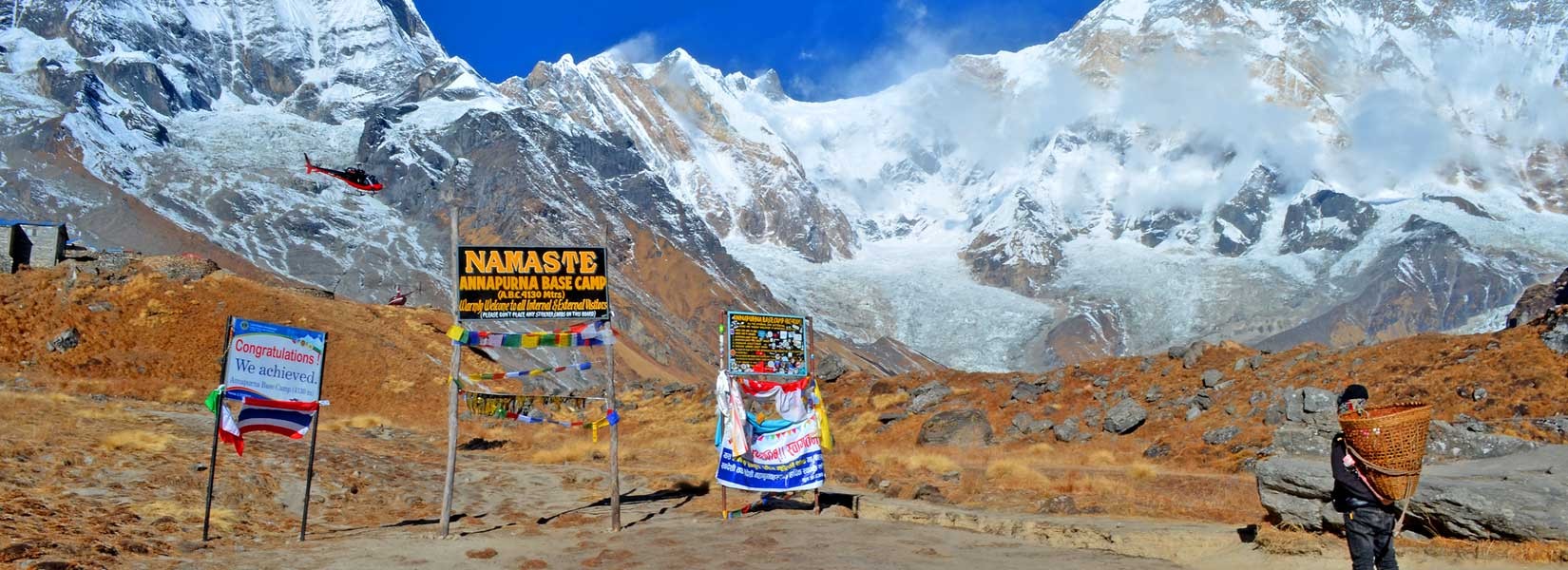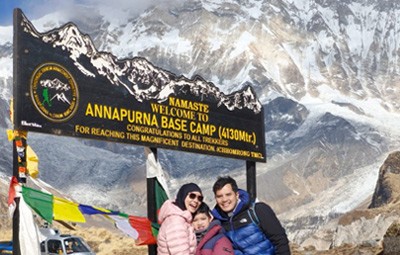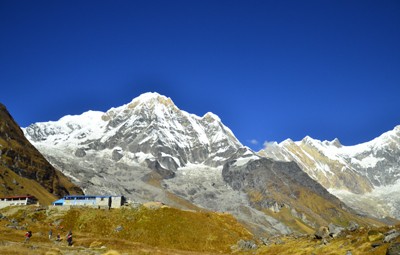Best time to do the Annapurna Base Camp Trek in 2026
Trekking in Nepal at Annapurna Base Camp in Annnapurna Region during the best time of year—that’s everyone's choice and probably a dream for everyone. As we mentioned earlier about the 4 different seasons of Nepal, if we write by months by saying trekking in Nepal Annapurna base camp in April or in December, it won’t sound that interesting, or should we? Suggest you later after reading it. How to prepare for the Annapurna base camp trek at different times of the year would be helpful tips, which we are going to write on this travel blog.
Annapurna Base Camp Trek in Winter Season ❄️⛰️
The wintertime Annapurna Base Camp journey in Nepal provides a breathtaking view of landscapes and forests blanketed in snow. Trekkers, however, face difficulties because of the frigid temperatures, which can reach -20°C at night in higher elevations. Notwithstanding the challenges, anyone with prior experience hiking in the winter months in the Himalayas and physical and mental preparation can take on this expedition to enjoy the spectacular grandeur and breathtaking vistas. Between December and February, the average maximum and lowest temperatures are 9.3°C to -14°C, 7°C to -19°C, and 6°C to -20°C, respectively.
A notable advantage of trekking to Annapurna Base Camp (ABC) during the winter season is the opportunity to witness the majestic Himalayas blanketed in a thicker layer of snow. For those who relish winter activities and enjoy playing in the snow, this season is an ideal choice. 5-days Annapurna base camp trekitinerary is not for beginners during winter season, so better to choose some other options.
While reaching Annapurna Base Camp can be challenging due to heavy snowfall, it's not impossible. During the winter, avalanche risk is another significant factor on this ABC Trekking Trail. Booking with a reputed Nepal Trekking Company (Rugged Trails) and having an experienced guide who is familiar with the trail and can identify potential hazards is crucial.
Weather conditions can change rapidly, impacting your trekking experience. As the images illustrate, some trekkers have been fortunate to witness stunning views, while others have only been able to enjoy walking in the snow. While neither you nor I can predict the weather, it's important to monitor weather reports daily for the latest updates. A winter trek in the Nepal Annapurna Himalayas requires careful preparation to ensure comfort and safety in the harsh conditions. Must carry warm and appropriate trekking gear for the winter ABC trek (packing list).The below list is not just for the Annapurna Trek but also applies to Everest Base Camp, Annapurna Circuit, 3 Passes Trek Manaslu, or any other high-mountain trek.
Here's a list of essential items to pack:
Clothing
- Base Layers: Thermal underwear (tops and bottoms) for warmth and moisture-wicking.
- Mid-Layers: Fleece jackets or sweaters for insulation.
- Insulating Jacket: A high-quality down or synthetic-filled jacket for extreme cold.
- Waterproof Jacket and Pants: A breathable, waterproof shell to protect against snow and rain.
- Warm gloves and Mittens: multiple pairs for varying temperatures.
- Warm Hat and Scarf: To protect your head and neck.
- Sun Hat: To protect your face from the sun's rays, even in winter.
- Sunglasses: To protect your eyes from the glare of snow and ice.
Footwear
- Waterproof trekking boots: with good ankle support and traction.
- Lightweight hiking socks: To prevent blisters.
- Crampons: Easily attached to your hiking boots, these metal spikes offer superior traction on icy and snowy surfaces. Particularly on steep slopes and glaciers, they are essential for stability and safety.
- Gaiters: To shield your feet from snow, filth, and debris, gaiters are waterproof coverings that fit over your boots and down to your ankles. They are especially helpful in keeping snow out of your boots, which can cause irritation and frostbite.
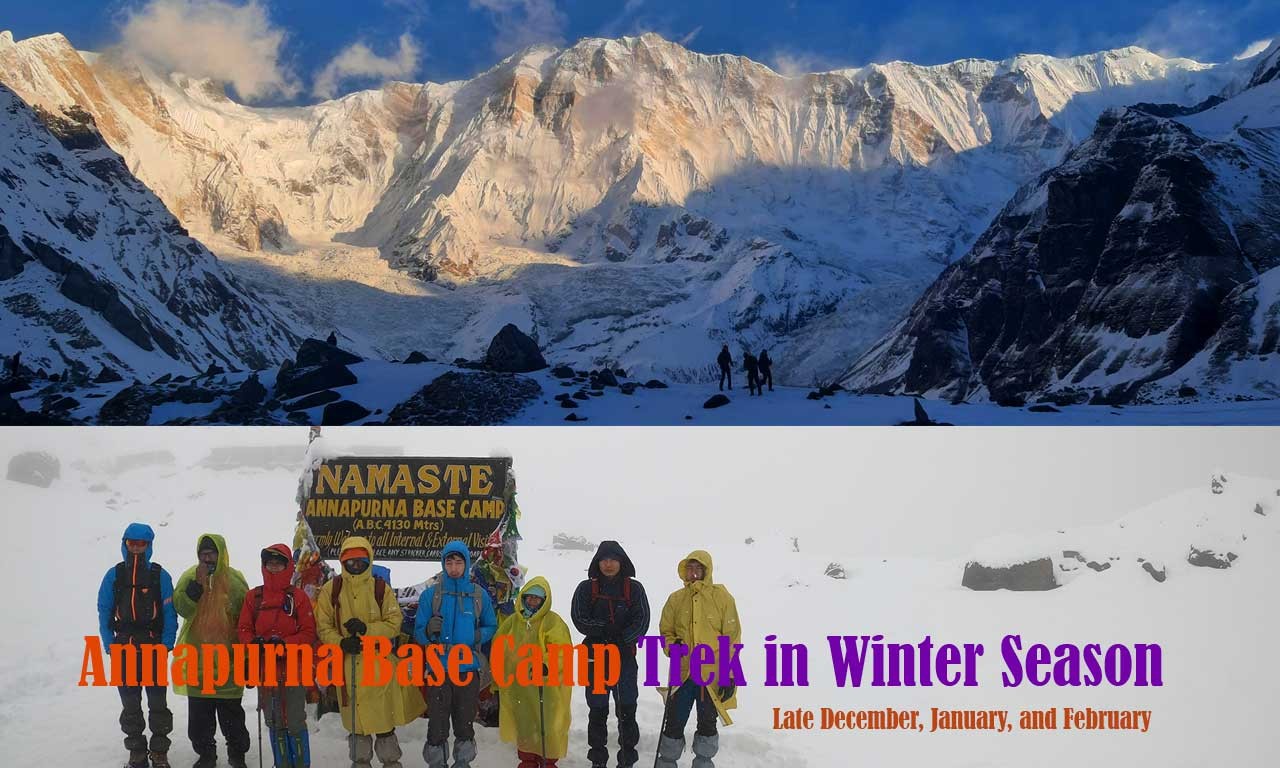
Annapurna Base Camp Trek in Monsoon (Summer) Season 🌧️☁️
The Annapurna Base Camp expedition offers a once-in-a-lifetime experience, and it is best enjoyed during the monsoon season, which is the summer season. Despite the fact that there is a significant amount of precipitation in the region, which causes the ground to become muddy and slippery, as well as leeches, landslides, and flooding in certain areas, the average daily temperature is between 18 and 25 degrees Celsius, which provides some reprieve from the brutal cold of winter. You can tolerate the cold at night if you dress adequately, despite the fact that it can get cold at night. Trekking offers a number of advantages, one of which is the opportunity to witness the region's vibrant splendor at its height during the summer months. During the months of June, July, and August, the average maximum and minimum temperatures range from 16 degrees Celsius to 3 degrees Celsius, 18 degrees Celsius to 6 degrees Celsius, and 19 degrees Celsius to 7 degrees Celsius, respectively.
There are several disadvantages to consider when planning a trip to Annapurna Base Camp (ABC), even after investing significant time and money. These include persistent rain, leeches along the trail, landslides, and the possibility of not seeing the Himalayan peak, which can be frustrating.
Regardless of the leeches, clouds, rain and landslides there are some excellent trek reviews for Annapurna Base Camp by some trekkers. They praise the incredible evening and morning views from ABC as a major highlight of the trek."
Despite the challenges, there are many wonderful memories to be made. You'll encounter breathtaking waterfalls, colorful flowers, lush greenery, shepherds with their flocks, and incredible photo opportunities with vibrant wildflowers against the backdrop of snow-capped Himalayan peaks. With fewer people on the trail, you'll have a more personalized experience. Less people will have altitude sickness during this time, as in our experience. Imagine scenes similar to those depicted in the Annapurna Base Camp photos below.
Comprehensive list of essential trek gear for the monsoon season.
Essential Clothing
- Waterproof Outerwear: To survive prolonged rains, a good rain jacket and rain pants are essential.
- Base Layers That Quickly Dry: Opt for materials that drain away moisture and dry rapidly, such as polyester or merino wool.
- Warm Mid-Layers: For extra warmth in chilly weather and at night, layer up with down coats or fleece.
- Hiking Pants: Choose sturdy, water-resistant pants that can tolerate rain and muddy paths.
- Wearing a waterproof hat and gloves will help you shield yourself from the weather.
Essential Shoes:
- Waterproof hiking boots: For settling on muddy routes and possible river crossings, sturdy, waterproof hiking boots with adequate ankle support are a must.
- Trekking Socks: To avoid blisters, use cozy, moisture-wicking trekking socks.
Essential Equipment:
- Trekking Poles: Trekking poles can help with stability on slippery trails and reduce strain on your knees.
- Poncho: A lightweight poncho can provide extra protection from rain and wind.
- Gaiters: Gaiters help keep debris and mud out of your boots.
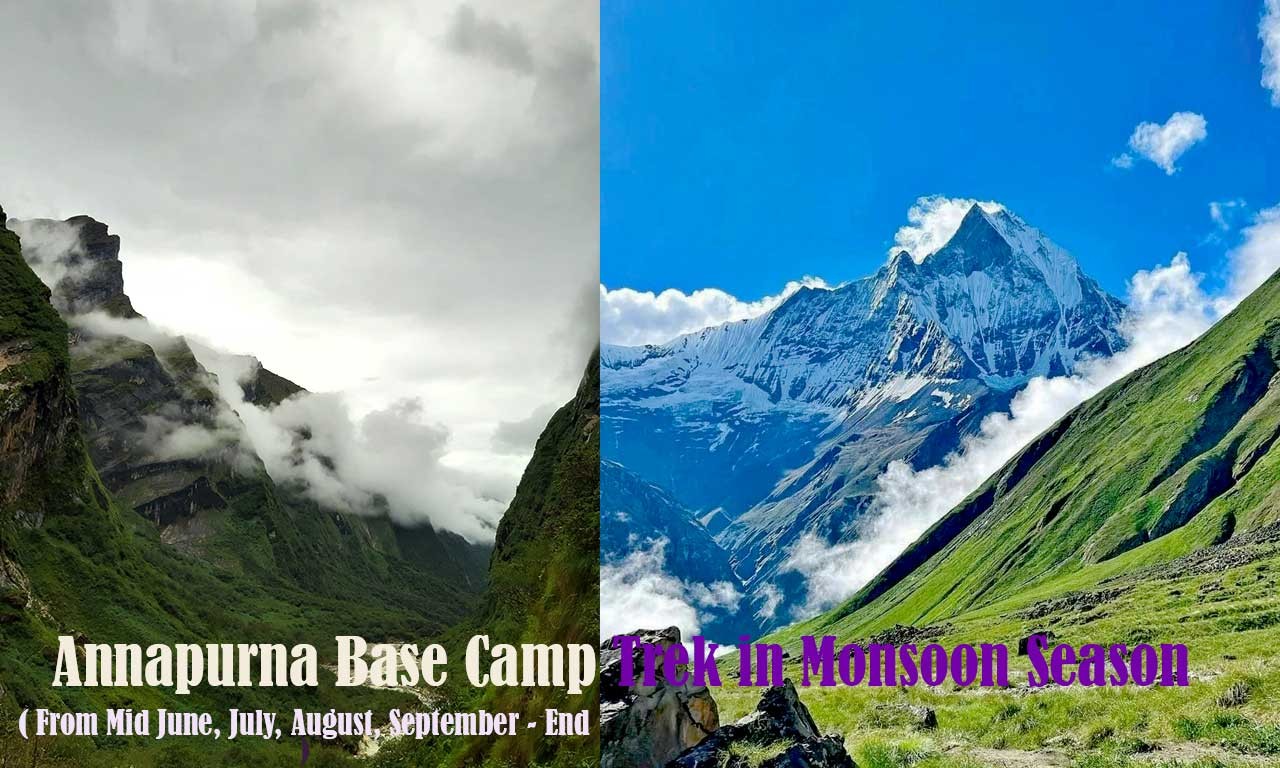
Annapurna Base Camp Trek in Spring Season 🌸🌄
When it comes to trekking in Nepal's Annapurna Region, the Annapurna Base Camp trip is best experienced during the springtime, which includes the months of March, April, and May. During the month of April, snow is melting and sunny skies provide breathtaking vistas of the Himalayas. This month is particularly perfect. The trail is made more beautiful by the bright flowers that bloom in the trees in the area and the snow-covered Himalayan peaks of Nepal. As a result of rising temperatures, the climate deteriorates. Additional factors that contribute to the allure of this season for the trek include the low amount of precipitation and the good temperature. During the months of March, April, and May, the average maximum and minimum temperatures range from 4 degrees Celsius to -8 degrees Celsius, 8 degrees Celsius to -4 degrees Celsius, and 14 degrees Celsius to 0 degrees Celsius, respectively.
It is recommended that you plan a somewhat longer Annapurna Base Camp Trek via Ghorepani Poon Hill during this season. This is due to the fact that the best views of the Rhododendron are located around Ghorepani, Poon Hill, and the climb to Tadapani. Consider whether you still have a few days left. The shortest ABC trip, which is five days, won't cover Poon Hill, which is ideal.
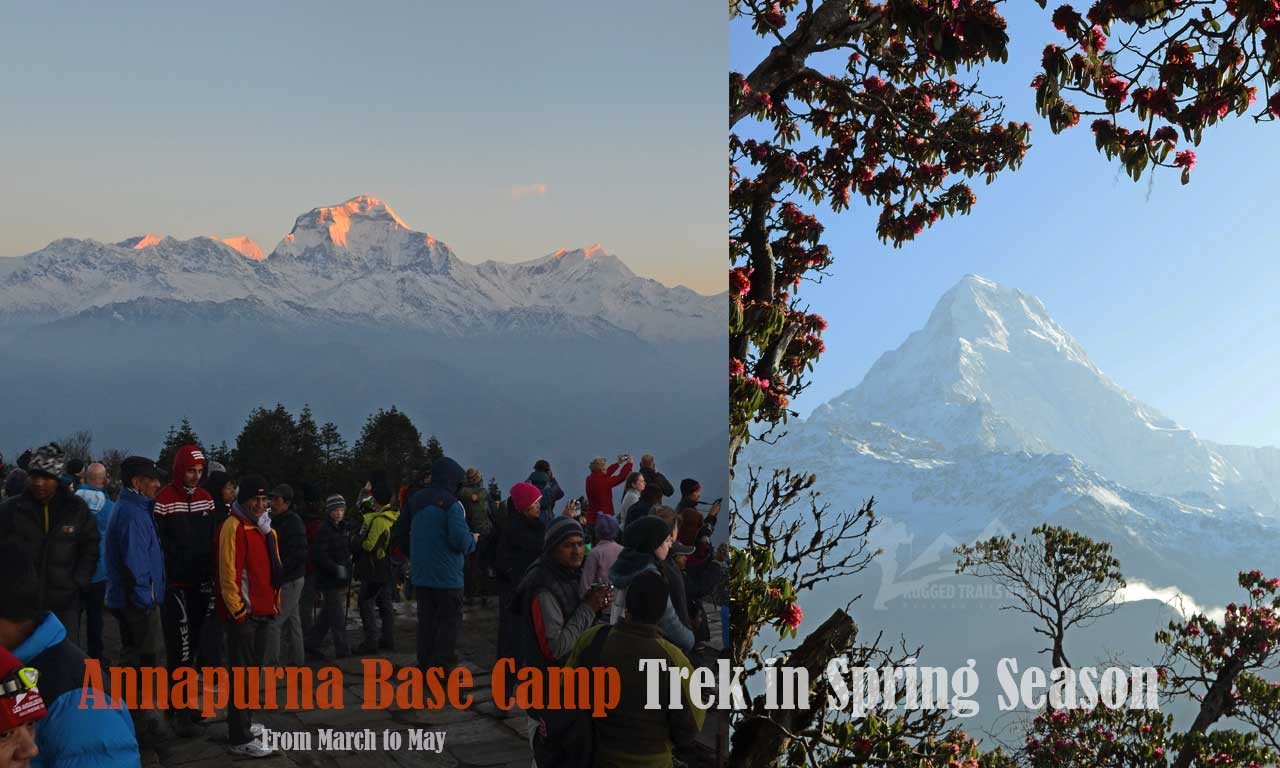
Annapurna Base Camp Trek in Autumn Season 🍂🌅
The best time to hike to Nepal Annapurna Base Camp is thought to be in the autumn (fall), specifically in October. The greatest balance of picturesque scenery and agreeable weather can be found during this time of year. The region has its autumnal season from mid-September to the end of November. Beautiful sunrises and sunsets can be seen under clear skies, along with unhindered views of the Himalayan ranges. The rainy season refreshes the terrain, enhancing its aesthetic appeal. Though not very cold at first, November sees a steady decrease in temperature. October and November had average minimum and maximum temperatures of 20°C to 0°C, 16°C to -6°C, and 11°C to -10°C, respectively.
Aumun season is not only a popular season to trek in Nepal for the glorious Himalayan views and clear skies but also the greatest festive time of the year. People celebrate Dashain and Tihar festivals in various parts of trekking routes, so find out when these festivals are celebrated in Kathmandu and other parts of Nepal.
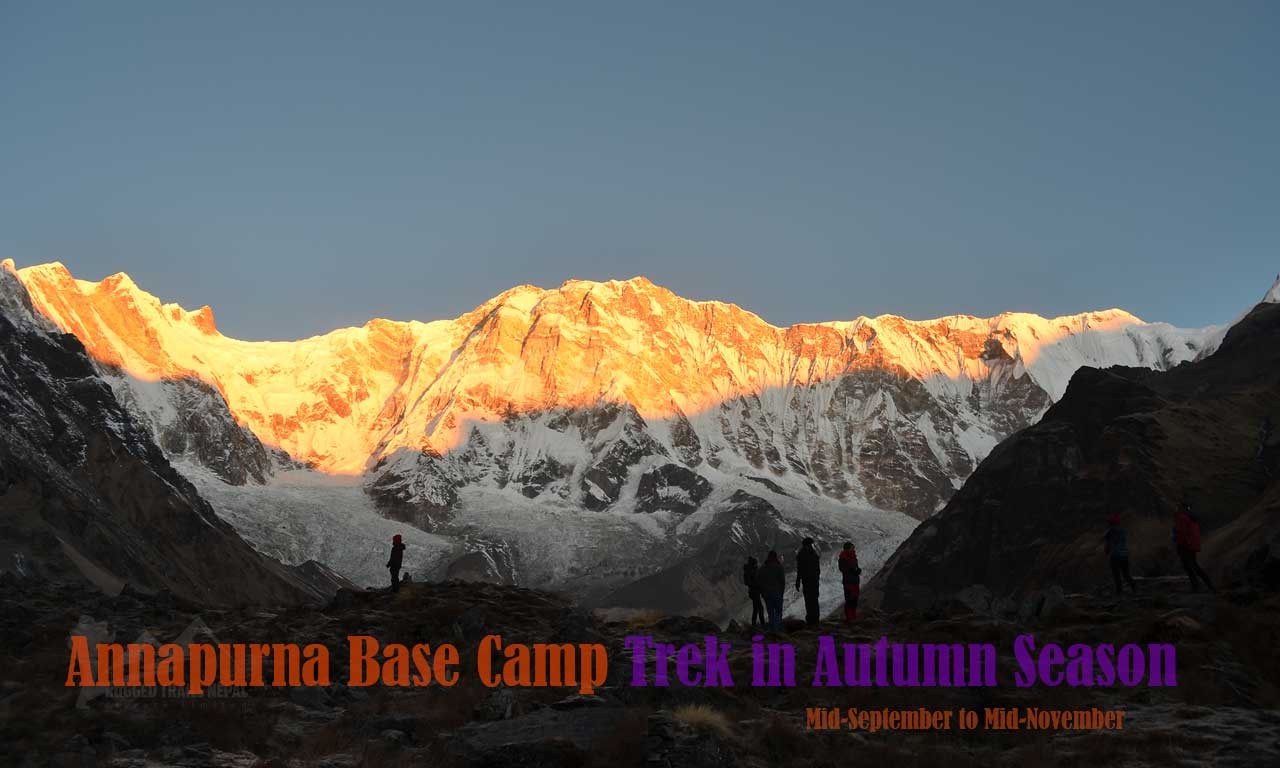
Related ABC Trekking Packages and Travel Blog
In summary
The Annapurna Base Camp Trek offers a truly unforgettable experience, and the best time to embark on this adventure depends on your preferences and priorities.
- Winter (December–February): Take in the breathtaking scenery covered with snow, but be ready for hard weather and possible setbacks.
- Monsoon (June–August): See the area at its most colorful and breathtakingly beautiful, but be ready for rain, leeches, and possible landslides.
- Spring (March–May): Take in the lovely weather and blossoming rhododendrons, but be mindful of the possibility of snowfall and temperature swings.
- Autumn (September–November): Take advantage of the beautiful skies, nice weather, and the chance to see holidays like Tihar and Dashain
The Annapurna Base Camp Trek is best experienced at the season that best suits your tastes, level of physical fitness, and desired experience. To ensure you make the right choice, carefully weigh the advantages and disadvantages of each season. Always remember to pack for the proper season and be ready for the benefits and trials that the Annapurna Base Camp Trek has to offer.
- 👋 Let's Chat First: Have questions? Message us on WhatsApp for a friendly, no-pressure conversation.
- ✍️ Plan My Perfect Trip: Ready to start your journey? Send us an inquiry to customize your ABC Trek.

